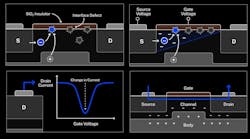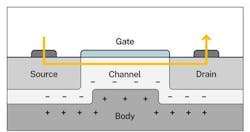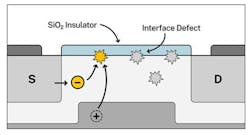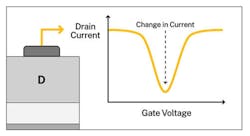NIST, Collaborators Develop New Way of Detecting the Defect Density in Transistors
Defects in transistors, such as unwanted impurities and broken chemical bonds in the various layers of the semiconductor, can limit their performance and reliability. These defects are becoming harder to identify as transistors get smaller and they operate ever faster.
Over many years, scientists have developed several ways to classify and minimize these defects. But for some promising semiconductor materials being developed, such as silicon carbide for high-energy, high-temperature devices, there has been no simple and straightforward way to count and characterize defects.
That should change since a team of researchers at the National Institute of Standards and Technology (NIST) have devised and tested a new, highly sensitive method of detecting and counting transistor defects. The method focuses on interactions between a transistor’s two kinds of electrical charge carriers: negatively charged electrons and positively charged “holes,” which are spaces where an electron is missing from the local atomic structure.
“The method we developed works with both traditional Si and SiC transistors, letting us for the first time identify the type of defect and how many are in a given space (defect density) using a simple DC measurement,” says James Aston, a NIST researcher.
When a transistor functions correctly, a specific electron current flows along the desired path. If the current encounters a defect, electrons get trapped or displaced, and can then recombine with holes to form an electrically neutral area. Each recombination removes an electron from the current. Several defects cause current losses, and they lead to malfunctions. The goal of the NIST team was to determine where the defects are, their specific effects and, ideally, how many there are.
“We wanted to give semiconductor companies a way to identify and quantify defects as they test different new materials,” says NIST’s Jason Ryan. “We did that by modeling a defect-detection technique that has been widely used but poorly understood. We then conducted proof-of-principle experiments that confirmed the model.”
In a classic metal oxide semiconductor design, a metal electrode, aka the gate, is placed atop a thin insulating silicon dioxide layer. Below that is the bulk body of the semiconductor.
On one side of the gate is an input terminal, called the source; on the other is an output, the drain. Researchers investigating the dynamics of current flow change the bias voltages applied to the gate, source and drain, all of which affect how current moves.
In the new work, NIST, working with Penn State researchers, focused on the boundary, or channel, between the thin oxide layer and the bulk semiconductor body. It typically measures about 1 billionth of a meter thick and a millionth of a meter long.
This layer is hugely important because the effect of a voltage on the metal above the transistor’s oxide changes how many electrons are within the channel. This region controls the resistance of the device from source to drain, and the region’s performance is a function of how many defects it contains. Earlier detection method could not how many defects were in this layer.
The NIST team refined one method of detecting defects in the channel called electrically detected magnetic resonance (EDMR). It uses principles that make medical MRIs possible. Particles such as protons and electrons have spin, a quantum property that makes them act like bar magnets with two opposite magnetic poles. In EDMR, the transistor is irradiated with microwaves at a frequency about four times higher than those used in microwave ovens. Experimenters apply a magnetic field to the device and gradually vary its strength while measuring the output current.
At exactly the right combination of frequency and field strength, electrons at defects “flip” (reverse their poles). This causes some to lose enough energy that they recombine with holes at defects in the channel, reducing the current. Channel activity is difficult to measure, however, because the high volume of “noise” coming from recombining holes in the semiconductor.
To refine the method and focus on activity in the channel, researchers used the bipolar amplification effect (BAE), which can be done by adjusting the bias voltages applied to the source, gate and drain.
Because of the biasing, we measure current levels at the drain,” Ashton says, “We eliminate interference from other things going on in the transistor. We select just defects we care about within the channel.”
How BAE operates was not known until the team developed its model. “The only measurement results were qualitative, that is, they could tell the kinds of defects in the channel but not the number,” says Patrick Lenahan, a professor of engineering science and mechanics at Penn State.
Before they modeled BAE, it was used strictly as a resource for applying voltages and controlling currents for EDMR measurements, which is useful for qualitative defect identifications. The new model lets BAE quantitatively measure the number of defects and do so with just from currents and voltages. This lets the BAE model gives researchers a mathematical description of how the BAE current is related to defect density.
The model, which the researchers tested in a set of proof-of-concept experiments on metal oxide semiconductor transistors, makes quantitative measurements possible.
“Now we can account for variations in charge carrier distribution throughout the channel region,” explains Ashton. “This opens up the possibilities of what can be measured with a simple electrical measurement.”
“This technique can provide insight into destabilizing transistor defects and a path to mechanistic understanding of their formation,” says Markus Kuhn, formerly at Intel and now senior director of semiconductor metrology and fellow at Rigaku, who was not involved in the research. “With such knowledge, there would be greater opportunity to control and reduce them to improve transistor performance and reliability. This would be an opportunity to further enhance design of the chip circuitry and device performance leading to better performing products.”




